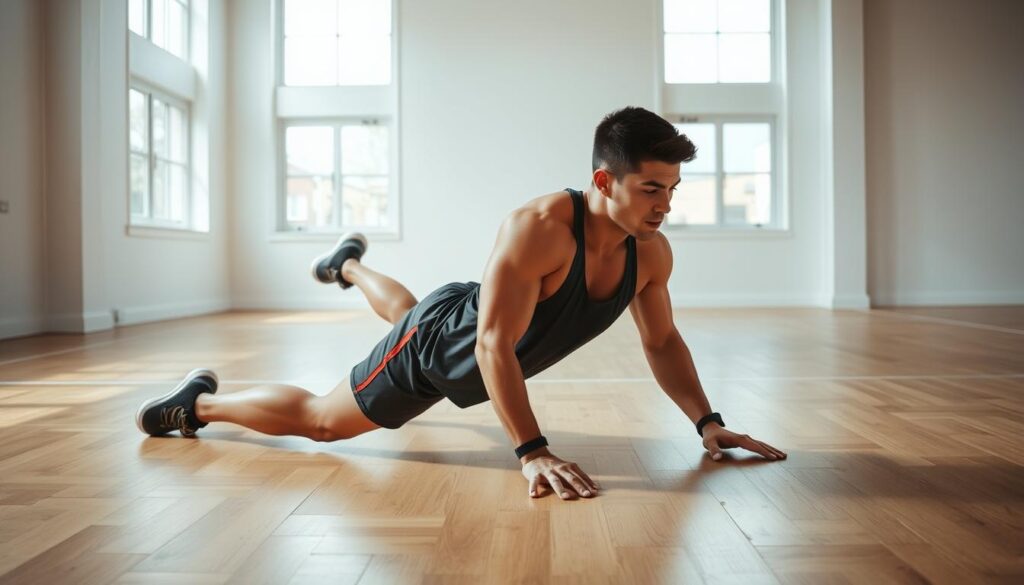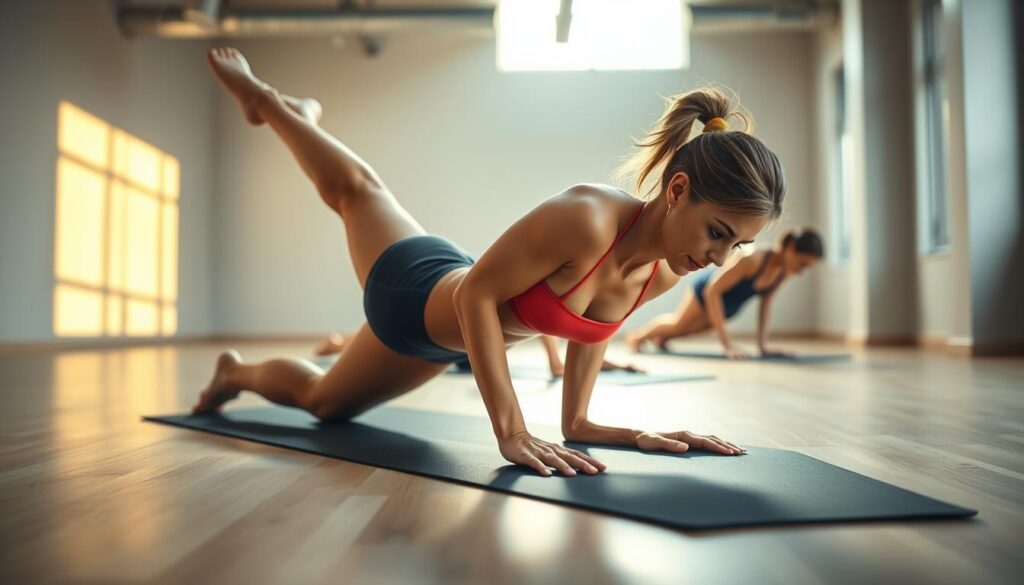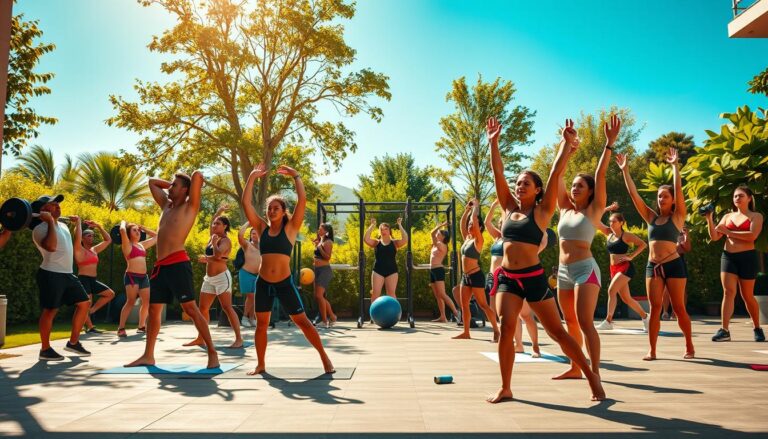
Imagine you’re running and your hips start to wobble. Your back tightens, and every step feels hard. This is because of your core. It’s not just about looking good; it’s essential for moving well.
A weak core can slow you down and even hurt. But, the good news is that working on your core can make you faster and stronger. You don’t need fancy equipment; simple bodyweight exercises can do the trick. Let’s explore how strengthening your core can change your workouts and daily life.
Your core is like your body’s powerhouse. When it’s strong, you can move with ease. Whether you’re playing with kids, carrying groceries, or trying to beat your personal best, a strong core helps.
But many people ignore their core until they start to hurt. This article will show you why core workouts are key. You’ll learn about the muscles involved, how to avoid mistakes, and routines that fit your busy schedule. Say goodbye to endless crunches and hello to smart, effective exercises that keep you stable and injury-free.
Key Takeaways
- Core strength improves running speed, endurance, and injury prevention.
- Effective core workouts don’t require equipment—bodyweight exercises work.
- A strong core supports better posture, lifts, and daily movements.
- Targeting all core muscles (rectus abdominis, obliques, and more) boosts athletic performance.
- 30 minutes of core workouts 3x/week can transform your stability and energy efficiency.
Understanding Your Core: More Than Just Abs
Your core is more than just abs. It’s a group of muscles that are crucial for your body. Knowing which muscles are important is the first step to building core strength.
The Anatomy of Your Core Muscles
Think of your core as a team of muscles working together. Key players include:
- Rectus abdominis: Flexes the trunk (like a sit-up)
- Transverse abdominis: Acts like a built-in corset, holding your spine stable
- Obliques: Rotate your torso and stabilize when bending sideways
Why Core Strength Matters for Daily Life
Poor core strength can lead to back pain and slouching. It can even make lifting groceries hard. A 2015 study found planks are better for your core than crunches.
Weakness in your core makes everyday tasks harder. Imagine lifting a child or bending to tie shoes. Your core handles all that.
The Connection Between Core Stability and Overall Fitness
Stability exercises like side planks or bird dogs train muscles to work together. This boosts athletic performance—think golf swings or running. Gyms like F45 and CrossFit use these moves to build power.
Even Pilates’s reformers target deep muscles like the multifidus, reducing back pain. Aim for 2-3 workouts weekly.
Stability exercises don’t just tone your midsection—they’re your body’s foundation for movement. Strengthening this network of muscles improves everything from workouts to how you carry groceries. Ready to start? Let’s dive into how to train it effectively.
The Remarkable Benefits of Regular Core Workouts
Regular core workouts do more than just give you a six-pack. They are the base of your body’s strength, stability, and health. By strengthening your core, you build muscles that support daily activities and sports.

- Stronger posture: A 2017 study found weak cores lead to back pain, especially in heavy people. Strengthening your midsection helps align your spine, easing back and neck pain.
- Better athletic performance: Core strength is key for movements like lifting, running, or carrying heavy things. A 2019 study showed athletes got better balance and endurance after 8 weeks of core training.
- Reduced injury risk: Weak cores make other muscles work harder, leading to injuries in hips, legs, or backs. Exercises like planks or bridges help keep your body stable, reducing injury risk.
- Long-term health: The National Institute on Aging says core strength helps prevent falls in older adults. A 2021 review found daily core exercises improved seniors’ independence and quality of life.
The American Heart Association suggests doing strength training twice a week. Exercises like deadlifts or yoga poses build strength without hurting your spine. Avoid sit-ups and choose exercises that work your whole core safely.
Being consistent is key. Even 10 minutes of core exercises a day can strengthen your muscles. Add mindful movements, like standing tall while working, to get the most benefits. A strong core means less pain, more energy, and moving with confidence.
Foundation Core Exercises for Beginners
Building a strong core is easy without fancy equipment. Start with bodyweight exercises and plank variations. These help activate your midsection safely. Focus on getting the form right to avoid injury and build stability.
Basic Plank Variations to Master First
Start with these basic holds to strengthen your core:
- Forearm Plank: Hold for 20–40 seconds, keeping hips level with shoulders.
- Side Plank: Balance on one forearm and feet, holding 15–30 seconds per side.
- Reverse Plank: Sit with hands behind hips, lift hips into a tabletop position for 20–30 seconds.

Simple Bodyweight Movements for Core Activation
Try these moves for a balanced workout:
| Exercise | Reps | Form Tips |
|---|---|---|
| Dead Bug | 8–15 per side | Keep lower back pressed to the floor. |
| Bird Dog | 6–12 per side | Align shoulders and hips while extending limbs. |
| Glute Bridge | 10–12 reps | Squeeze glutes at the top for full engagement. |
Creating Your Starter Core Routine
Try this 12-minute sequence 2–3 times weekly:
- Forearm plank: 20 seconds → 20-second rest (3 rounds)
- Dead Bug: 2 sets of 10 reps per side
- Bird Dog: 2 sets of 8 reps per side
- Glute Bridge: 3 sets of 12 reps
Breathe steadily and pause if form falters. Progress gradually by adding time or reps as you gain strength.
Essential Core Workouts for Total Midsection Strength
To build a strong core, you need to work every part of your midsection. Start with these abdominal exercises and core workouts. They target your upper abs, lower abs, obliques, and full-body stability. Weak deep core muscles can lead to back pain, so focus on exercises that work all layers.

Start with upper abdominal routines. Crunches and sit-ups work your top abs. Add weights to crunches for more challenge. For your lower abs, try leg raises or reverse crunches. These lift your lower back and work your lower abs.
Flutter kicks also target your lower abs.
Next, oblique exercises like Russian twists or side planks improve rotational strength. Use a medicine ball for twists or try woodchoppers with resistance bands. These movements mimic real-life twisting motions, boosting functional fitness.
Finally, full core integration comes through compound moves. Mountain climbers, hollow rocks, and Turkish get-ups force your entire core to stabilize. Aim for 3 sets of 12-15 reps per exercise, progressing by adding weight or slowing movements.
Always engage your deep core by drawing your belly button inward during core workouts. If you have back issues, consult a professional before starting. Mix these routines 2-3 times weekly for balanced strength gains.
Incorporating Equipment to Enhance Your Core Training
Adding equipment to your workouts can boost your core strength. Tools like resistance bands and stability balls challenge your body in new ways. They help you get better results without needing a gym membership. Let’s see how gear can make your routine better.

- Resistance bands: Loop bands add tension to moves like side bends or pallof presses. They build stability and strength training endurance.
- Stability balls: Crunches on a ball engage deeper muscles than floor exercises. They improve balance and core control.
- Medicine balls: Rotational throws or Russian twists with weighted balls build explosive power. This is good for sports or daily activities.
- Cable machines: Cable woodchops target rotational stability. They mimic real-life movements like swinging a bat.
Even small investments can make a big difference. Airex foam rollers help with rollout exercises. TRX straps let you do suspended planks. Studies show stability equipment can boost core engagement by 25%, making workouts more effective.
“The right tools turn basic moves into advanced challenges, ensuring your core strength grows steadily.”
Pair equipment with bodyweight exercises to avoid plateaus. For example, combine cable rotations with standard planks for balanced development. Focus on form first—then gradually add resistance. Whether using a $10 band or a gym setup, smart choices keep progress steady. Your core’s potential is limitless—equip it to shine.
Dynamic Core Exercises for Functional Strength

Building functional strength means training your core to move like it does in real life. Dynamic exercises like rotational throws and anti-rotation holds prepare your body for daily tasks and sports. These moves engage your obliques, spinal stabilizers, and even glutes for balanced strength training results.
Rotate to build power. Exercises like medicine ball slams and cable woodchops teach your obliques to generate force quickly. Try these:
- Medicine ball slams: 4 rounds of 30 seconds
- Russian twists with a medicine ball: 3 sets of 15 reps
- Cable chops: 3 sets of 12-15 reps
These oblique workouts boost performance in sports like tennis or gardening. Rotate safely—keep your spine neutral to avoid strain.
Stability matters. Anti-rotation drills like Pallof presses teach your core to resist twisting forces. This prevents injuries and improves posture. Try:
- Pallof press: 3 sets of 8-10 reps
- Single-arm farmer’s carries: 3 rounds per side
“Anti-rotation training cuts injury risk by strengthening core stability,” say experts.
Start with 30-second holds and progress slowly. Proper form reduces spine strain.
Combine core engagement with full-body lifts. Deadlifts and squats build functional strength training that translates to lifting groceries or hiking. Key moves include:
- Deadlifts: 3 sets of 8-10 reps
- Turkish get-ups: 3 sets of 6-8 reps per side
- Plank pulls: 3 sets per arm
Pair these with controlled breathing—exhale during exertion. Compound moves integrate core stability with total-body strength for daily life resilience.
Common Core Training Mistakes and How to Avoid Them
Getting better at core strength means avoiding common mistakes. Many people mess up because of bad form, wrong breathing, or unbalanced workouts. Let’s look at how to fix these issues to get better results safely.

- Form Flubs: If you arch your lower back during planks, you’re not working your core right. Try to keep your back flat, squeeze your glutes and abs. This will help you stay straight from head to heels.
- Breath Blocking: Holding your breath too long can hurt. Breathe in deeply before starting, then breathe out as you work your core. For stability exercises like side planks, keep breathing steady to stay balanced.
- Overlooking Full-Body Balance: Not working your backside (glutes, hamstrings) can throw off balance. Do core exercises with moves like bridges and deadlifts to work your whole body together.
Breathe right: When doing stability exercises like bird dogs, breathe out as you stretch your limbs. If you find planks too hard, try shorter holds of 8–10 seconds. Mix in exercises that make you twist and turn to work all parts of your core.
Remember, it’s not about doing lots of reps. It’s about doing them right. Ditch the crazy crunches for focused, slow reps. Your core will do better if you train smart, not just hard.
Designing a Progressive Core Workout Plan
Building a stronger core is more than just doing random core workouts. You need a plan that gets harder over time. Start with basic bodyweight exercises. Then, make your body work harder with these steps:
- Increase time under tension: Hold planks longer or add reps to movements like the dead bug.
- Add instability: Use a BOSU® Balance Trainer or resistance bands during exercises like the Pallof press.
- Boost intensity: Progress from bodyweight planks to weighted planks or ab rollouts.

A 2020 study in the Journal of Physical Therapy Science found that progressive core training reduced chronic low back pain by improving stability and muscle endurance.
Here’s a 12-week plan to help you get better safely:
- Weeks 1-4: Learn the basics like planks, bird dogs, and hollow holds. Do 2-3 sessions a week, for 15-20 minutes each.
- Weeks 5-8: Add instability (like side planks on a stability ball) and resistance (with weighted vests). Try to hold for 60-90 seconds.
- Weeks 9-12: Try dynamic moves like rotational medicine ball throws. Aim for 30-45 second holds and do 3-4 sessions a week.
Always focus on doing the exercise right, not fast. Keep track of your progress by timing holds, counting reps, or feeling how movements get easier. Rest when you need to. Get 7-9 hours of sleep and eat lots of protein to help your muscles grow. A smart plan turns hard work into real results, whether you’re getting better from an injury or training for sports.
Specialized Core Routines for Different Fitness Goals
Core training isn’t for everyone. It depends on your goals. Whether you’re an athlete, recovering from back pain, or want better posture, you can tailor your workouts. Let’s explore how to adjust your routine for these specific needs.

For Athletes: Boost Performance with Rotational Strength
Boost your sport’s power with rotational exercises. Golfers and tennis players do well with medicine ball rotations. Runners should try planks with arm reaches. Do 3 sets of 8-10 reps, matching your sport’s movements.
- Russian Twist: 12 reps
- Medicine Ball Slams: 10 reps
Back Pain Relief: Prioritize Stability
Those with back pain should do low-impact exercises. Try Bird Dog or Dead Bug to engage deep muscles gently. Start with 2 sets of 8-10 reps, holding each for 5 seconds.
- Bird Dog: 10 reps per side
- Dead Bug: 12 reps
Improved Posture: Strengthen and Align
Fix slouching with exercises for postural muscles. Planks and Glute Bridges help realign your spine. Do 3 sets of 10-15 seconds for planks and 12 reps for bridges, squeezing your abs fully.
- Plank: 30-60 seconds hold
- Glute Bridge: 12 reps
| Goal | Focus Area | Sample Exercises |
|---|---|---|
| Athletes | Rotational power | Russian Twist, Medicine Ball Slams |
| Back Pain | Spinal stability | Bird Dog, Dead Bug |
| Posture | Postural muscle balance | Plank, Glute Bridge |
Gradually increase your workouts. Always check with a pro if you have injuries. Focus on consistency and proper form. Your core’s potential is huge with the right training.
Conclusion: Embracing Core Strength as Your Fitness Foundation
Your core is key for every move, from carrying groceries to running long distances. Core workouts aren’t just for visible abs. They build a strong base for health all your life.
Start with simple planks or bridges for 15 minutes a day. This can improve your posture and reduce back pain. As you get better, add in moves that twist or use weights. It’s more important to be consistent than to do too much at once. Try to work out 2-3 times a week, letting your muscles rest in between.
A strong core helps protect your spine, makes daily tasks easier, and boosts athletic performance. If you’ve had back pain, strengthening your core can really help. Mix core exercises with cardio and stretching for a well-rounded fitness routine. Always focus on doing exercises right to avoid injury and get the most benefit.
Think of building core strength as a long-term habit, not a quick fix. Beginners can start with simple floor exercises. More advanced folks can try harder planks or use a medicine ball. Stay hydrated, listen to your body, and celebrate small victories. Every plank or crunch brings you closer to better balance, less pain, and more energy.
Your core is the base of your strength. Build it slowly, and you’ll notice a big difference in everything you do. Ready to begin? Choose a plank variation today and focus on making progress, not being perfect. Your stronger, healthier self is worth the hard work.















